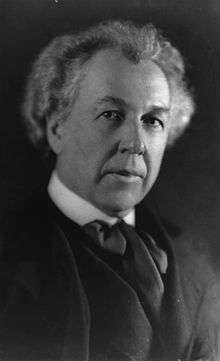Eric Lloyd Wright
| Eric Lloyd Wright | |
|---|---|
| Born |
November 9, 1929 Los Angeles, California |
| Nationality | American |
| Alma mater | University of California, Los Angeles |
| Occupation | Architect |
| Years active | 1948-present |
| Known for | Restoration of buildings by Frank Lloyd Wright |
| Spouse(s) | Mary Wright |
| Children | two sons |
| Parent(s) |
Frank Lloyd Wright, Jr Helen Taggart |
| Relatives | Frank Lloyd Wright grandfather |
Eric Lloyd Wright is an American architect, son of Frank Lloyd Wright, Jr and the grandson of the famed Frank Lloyd Wright.
Early life and education
Wright was born in Los Angeles on November 9, 1929 to Helen Taggart and Lloyd Wright (Frank Lloyd Wright Jr.). His father was a landscape architect and architect who was the eldest son of Frank Lloyd Wright Sr. Educated at the University of California, Los Angeles, Eric worked in his grandfather's (1948-1956) and father's (1956-1978) firm as an apprentice. He received his license as an architect in 1967.[1] before establishing his own firm Eric Lloyd Wright Architects and Planners in 1978. He lived in Topanga, California before moving to his present residence above Malibu.
Career and philosophy in architecture
"Wright’s early education as his grandfather’s apprentice at Taliesin and Taliesin West from 1948 to 1956 allowed him to partake in iconic projects such as New York’s Guggenheim Museum and Monona Terrace in Madison, Wisconsin."[1] He worked in his father's firm in Hollywood, California, until 1978 when his father died. Then he began his own firm of architects and planners.
Eric Lloyd Wright Architects and Planners does design and building, and Wright also leads a nonprofit called Wright Organic Resource Center. The firm's focus is on residences, often working with other architecture firms for final construction. He has worked on larger projects, including the Sunset Community High School.[2] He follows the concept put forth by his grandfather, termed Organic Architecture. "This “organic” concept not only predates the green-building trend of the past decade but also established the ideas that would come to be accepted as common sense concepts of smart design."[1]
The nonprofit Center provides educational programs on the grounds, which also include his home and the offices of his firm. The 24-acre site was purchased by his father in 1956, but never developed. Wright inherited the land from his father, and he has developed it slowly over the years, first as an office, and beginning in 1984, as his home.[3]
Most of Wright's work is in the United States. In 1995 he worked on housing in Japan, and in 1993 he helped established Chi-Am Group Incorporated and Chi-Am Consortium, two Chinese-American architectural firms.
Many of his personal and architectural records were burned in a 1993 fire at his home. He donated the papers and records of his father and grandfather to the University of California at Los Angeles prior to that, where they are safe from fires.[3][4]
Personal life
He lives with his wife Mary, a watercolor artist. They met in 1950 in Los Angeles. They have two sons.
Restoring Frank Lloyd Wright buildings
Wright is responsible for a number of restoration projects to his grandfather's buildings:
- Storer Residence - Los Angeles, California[5]
- Ennis Residence - Los Angeles, California
- Auldbrass Plantation - Yemassee, South Carolina
- Eric Lloyd Wright Boulder House - an adaptation of an original design by his grandfather in Malibu, California
- Greer Ranch - Murrietta, California
- Murrietta Oaks - Murrietta, California
Other projects
Other projects by Wright include:
- Walker Residence, Carmel, California
- Guggenheim Museum, New York, New York
- Gerald B. and Beverley Tonkens House, Cincinnati, Ohio
- Monona Terrace, Madison, Wisconsin
- The Wayfarer’s Chapel, Palos Verdes, California
- First Christian Church, Thousand Oaks, California
- The Good Shepherd Church, Des Plaines, Illinois
- The Institute of Mental Physics Joshua Tree, California
- Student & Faculty Housing Project for U.C., San Diego, California
- Solar Farms Project, Farming & Education, Apple Valley, California
- Humane Society Animal Shelter and Office, Ventura, California
- Swedenborge Church Conference Center, Westchester, Pennsylvania
- Visitor’s Center for The Wayfarer’s Chapel Palos Verdes, California - as consultant to Dean Andrews
- Tenemos Conference Center Dormitory for the Swedenborgian Church, Westchester, Pennsylvania - with Jay Cooperson
- Santaranta House, a private villa in Heinola, Finland
References
- 1 2 3 van Loon, Benjamin. "The Continuing Work of Eric Lloyd Wright". Green Building & Design (gb&d). Retrieved June 3, 2015.
- ↑ Wright, Eric Lloyd (February 20, 2000). "The State of Schools to Come: Different Schools of Thought". Opinion. Los Angeles Times. Retrieved June 3, 2015. line feed character in
|title=at position 51 (help) - 1 2 Talal, Jimy (December 24, 2014). "Eric Lloyd Wright: The Architect Who Couldn't Go Wrong". The Malibu Times. Retrieved June 3, 2015.
- ↑ Kamen, Ed (October 31, 2012). "New exhibit traces rebirth from '93 Malibu fire". The Malibu Times. Retrieved June 3, 2015.
- ↑ Ryon, Ruth (January 20, 1985). "Here's the Wright Stuff". Los Angeles Times. Retrieved June 3, 2015.
External links
- Eric Lloyd Wright, Chronology of Experience
- Eric Lloyd Wright, Personal History
- Mary Wright, artist
- Wright Way Organic Resource Center
- A fireproof House - Architect Eric Lloyd Wright July 25, 2007
